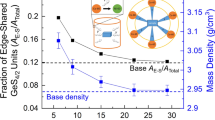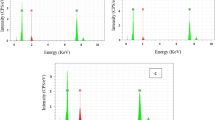Abstract
The contact angle of E and borosilicate glasses in various atmospheres such as air, steam, glycols, etc, show that the ambient atmosphere significantly affects the wetting behaviour of these glasses with platinum 20% rhodium alloy. The change in the contact angle is attributed to the bond formation between the cations and anions in the substrate, glass and atmosphere. Steam and oxygen which increase the non-bridging oxygens in the glass as well as increase the negativity of the glass surface increase wetting. Glycols and glycerins reduce non-bridging oxygens and increase the surface positivity groups which reduce wetting. As the requirement of oxygen for complete oxidation of atmospheric combustibles increases, the wetting increases and consequently the contact angle decreases.
Similar content being viewed by others
References
T. Young,Proc. Roy. Soc. December (1804).
Idem,Phil. Trans. Roy. Soc. (1805) 65.
J. R. Huntsberger,Chem. Eng. New 42 (1964) 44, 82.
B. Miller, “Surface Characteristics of Fibers and Textiles”, edited by M. J. Shick (Marcel Dekker, New York and Basel, 1975) Ch. 11.
M. C. Phillips andA. C. Riddiford,Nature 205 (1965) 1005.
A. B. Ponter, G. A. Davies, W. Benton andT. K. Ross,Int. J. Heat Mass Transfer 10 (1967) 1633.
G. Macdougall andC. Ockrent,Proc. Roy. Soc. Ser. A80 (1942) 151.
J. C. Sturas, C. C. Crabs andS. H. Gorland, NASA Technical Note TN D-3705 November (1966).
N. K. Adam, “The Physics and Chemistry of Surfaces” (Oxford University Press, London, New York, 1941).
G. E. P. Elloit andA. C. Riddiford,Nature 195 (1962) 795.
G. J. Copley, A. D. Rivers andR. J. Smith,J. Mater. Sci. 10 (1975) 1283.
N. M. Parikh,J. Amer. Chem. Soc. 41 (1958) 1.
F. Bashforth andJ. C. Adams, “An attempt to Test the Theories of Capillary Action” (Cambridge University Press, London, 1883).
D. N. Staicopolus,J. Colloid Interface Sci. 23 (1967) 453.
Fred Schlacter, US Patent 4235 614 (1979).
A. Paul andR. W. Douglas,Phys. Chem. Glasses 8 (1967) 151.
Author information
Authors and Affiliations
Rights and permissions
About this article
Cite this article
Simhan, R.G., Moore, L.L. & Van Gunten, P.R. Contact angle of E and borosilicate glasses in different atmospheres. J Mater Sci 20, 1748–1752 (1985). https://doi.org/10.1007/BF00555280
Received:
Accepted:
Issue Date:
DOI: https://doi.org/10.1007/BF00555280




